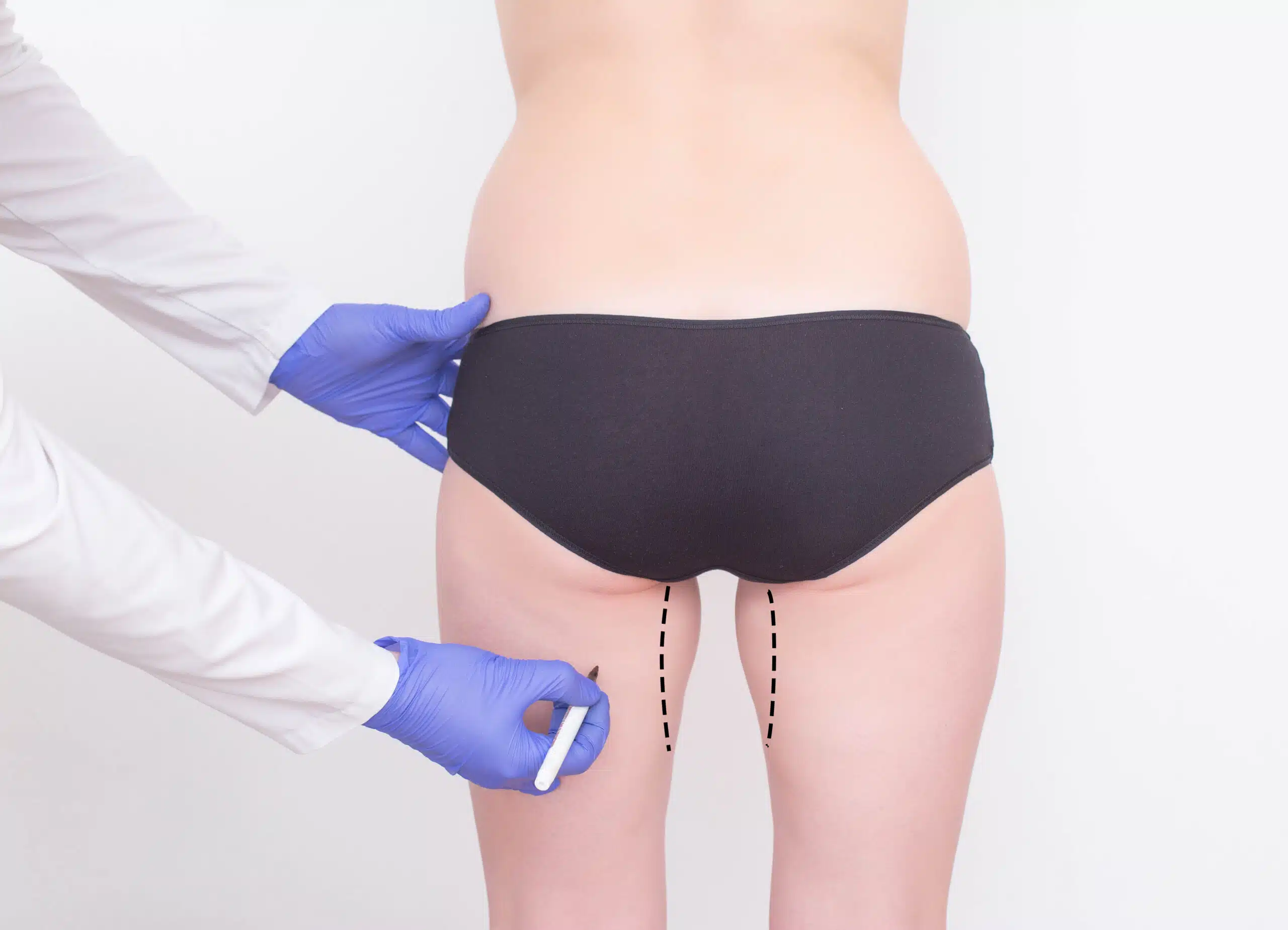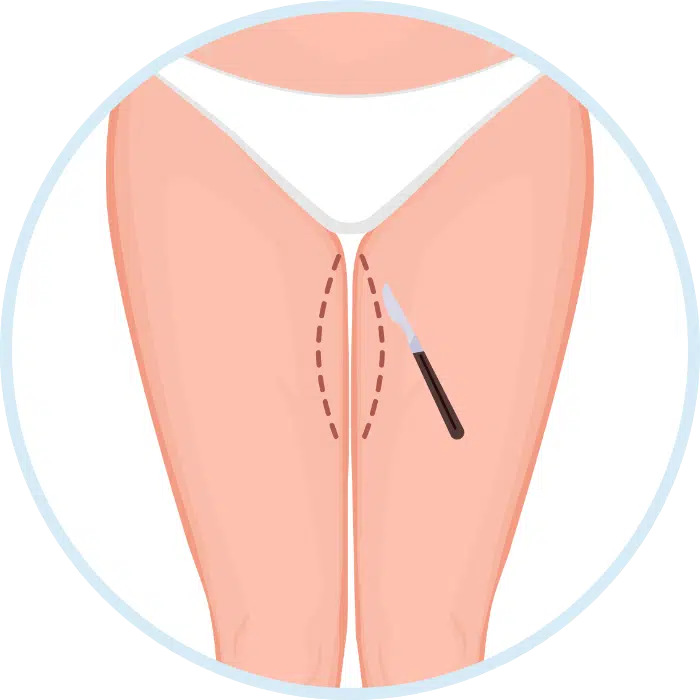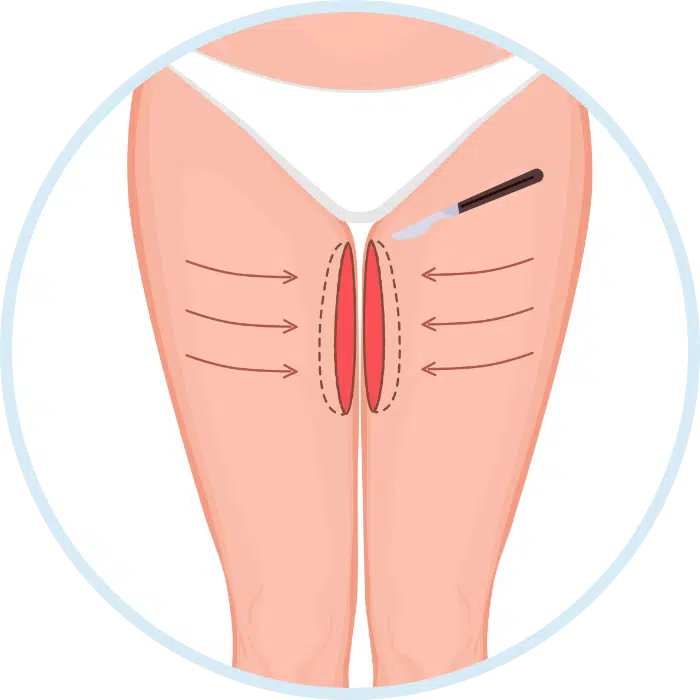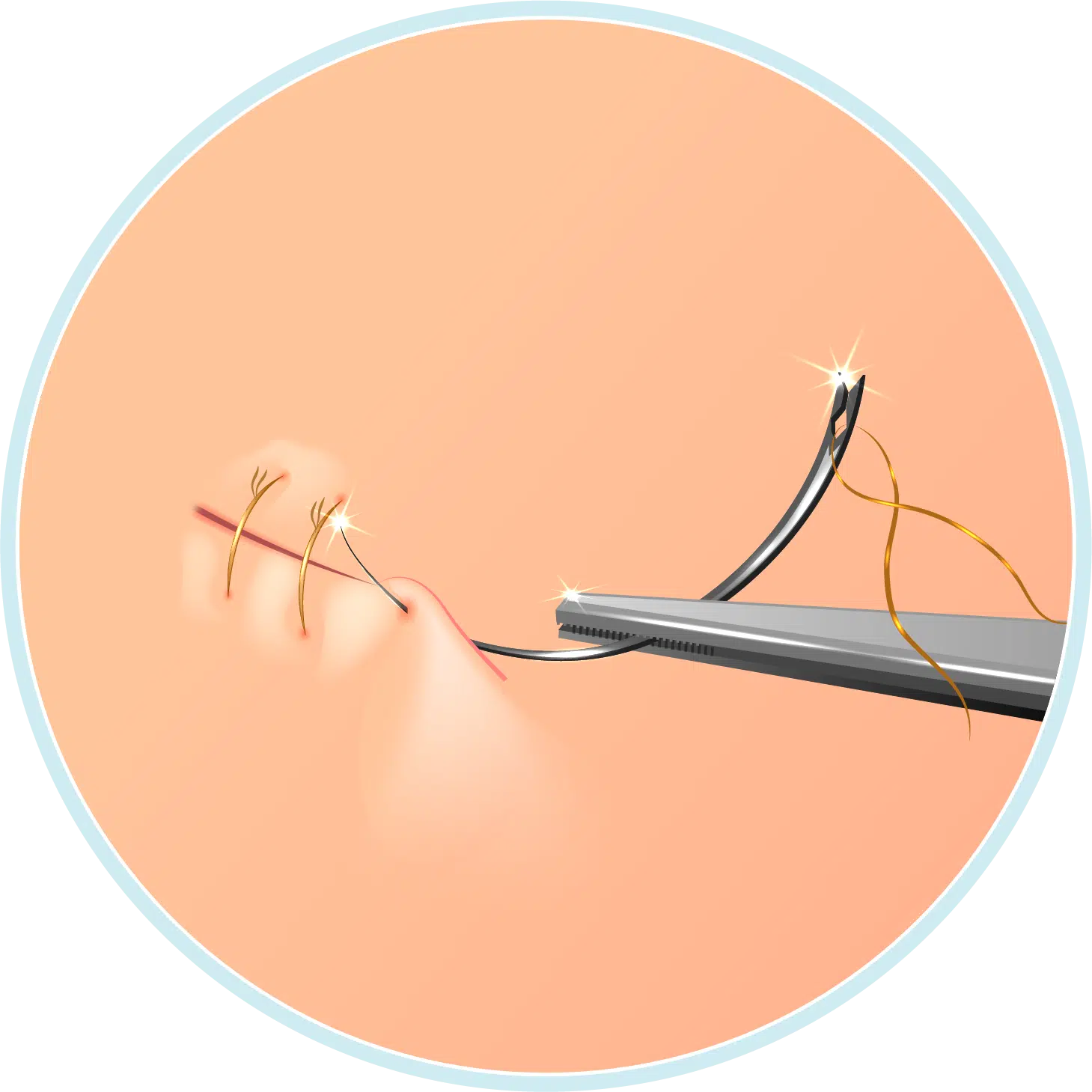Are you unhappy with the appearance of your thighs? Do you dream of having toned and sculpted legs through thigh lifts and thigh reduction? These procedures, along with body lift and liposuction, can help you achieve the confident and beautiful look you desire. Thighplasty, also known as a thigh lift, is a surgical procedure that can reshape and contour your thighs. It is often performed in conjunction with other procedures such as abdominoplasty, liposuction, body lift, and skin resection to achieve optimal results. If you’ve been searching for a solution to improve the appearance of your thighs, thighplasty may be the answer.
Thighplasty, also known as medial thigh lift, is a popular cosmetic procedure for individuals seeking to address excess skin or sagging in their thigh area. It is often performed in conjunction with liposuction for optimal results. Thighplasty can be combined with other procedures such as abdominoplasty and buttock augmentation to achieve a more comprehensive body contouring transformation. This liposuction and body lift procedure can help improve the overall look of your thighs and buttocks, giving them a more youthful and defined appearance. It is especially effective for addressing skin laxity. Whether it’s excess skin from weight loss or natural aging, thighplasty, also known as medial thighs, can address these concerns and give you the legs you desire. Thighplasty is a surgical procedure that focuses on improving the appearance of the thighs by removing excess skin and fat through liposuction. This procedure can be performed in conjunction with other body contouring surgeries such as abdominoplasty and body lift to achieve comprehensive results.
Performed under general anesthesia, thighplasty (also known as medial thigh lift) typically requires an overnight hospital stay. This procedure is commonly combined with abdominoplasty (tummy tuck) and liposuction to achieve optimal results. Additionally, some patients may choose to address excess fat or sagging skin around the knee area during their thighplasty surgery. Recovery time after posterior thigh resection and closure varies but generally takes several weeks before patients can resume normal activities due to soft tissue excess. It’s important to note that like any surgery, there are potential complications associated with thighplasty, including abdominoplasty, horizontal scar, deformity, and skin laxity. However, when performed by a skilled surgeon, resection and abdominoplasty can minimize risks for the patient with proper postoperative care.
So if you’re ready to say goodbye to sagging thighs and hello to beautifully contoured legs, consider thighplasty (body lift) as an option. Consult with a qualified plastic surgeon who can guide you through the abdominoplasty, medial thigh lift, thigh reduction, and body lift procedures. They will discuss whether vertical or horizontal techniques would best suit your needs.
Are you tired of dealing with uncomfortable chafing and rubbing between your thighs? If so, an abdominoplasty or body lift procedure may be the solution for you. These surgical options can help improve the appearance and comfort of your mons pubis area. Our experienced team is dedicated to providing exceptional care and results for every patient. If so, an abdominoplasty or body lift procedure may be the solution for you. These surgical options can help improve the appearance and comfort of your mons pubis area. Our experienced team is dedicated to providing exceptional care and results for every patient. The inner thigh lift procedure, also known as abdominoplasty, can be the perfect solution for those looking to improve the appearance of their mons pubis. This surgical resection and excision technique can provide the desired results. This type of thighplasty focuses on the excision and resection of excess skin from the inner part of the thighs, helping to eliminate friction and discomfort. It is similar to an abdominoplasty or body lift.
During an inner thigh lift, a skilled plastic surgeon will make incisions along the groin area and possibly extend them down towards the knee. This procedure may involve the excision of excess skin and fat in the upper thigh region, also known as abdominoplasty. This procedure may involve the excision of excess skin and fat in the upper thigh region, also known as abdominoplasty. Through these incisions, they will carefully remove any excess skin and fat, creating a smoother and more toned appearance for your inner thighs. This procedure is commonly known as an abdominoplasty or body lift, involving the excision and resection of excess tissue. This procedure is commonly known as an abdominoplasty or body lift, involving the excision and resection of excess tissue. By addressing the specific area of the upper inner thigh, an excision or resection can greatly improve not only the patient’s comfort but also their self-confidence.
Imagine being able to walk or exercise without feeling that irritating sensation caused by constant rubbing of the thigh skin. With thigh reduction, patients can experience relief from this discomfort through the excision of excess thigh skin. With an inner thigh lift, patients can bid farewell to those pesky skin irritations through the excision of excess upper thigh skin, and embrace a new level of freedom!
If sagging skin on the upper outer part of your thighs and buttocks is causing the patient distress, an excision outer thigh lift could be the solution. This type of thighplasty targets those areas prone to sagging, helping to sculpt your curves and enhance your overall body shape. The excision procedure is performed on the patient’s thigh, removing excess skin and fat to create a more defined contour. This line of treatment is designed to improve the appearance and proportion of the thighs. The excision procedure is performed on the patient’s thigh, removing excess skin and fat to create a more defined contour. This line of treatment is designed to improve the appearance and proportion of the thighs.
During an outer thigh excision procedure, a skilled surgeon will create incisions along the hip area extending towards the backside to remove excess skin and fat from the patient’s thigh line. Through these incisions, excess skin and fat are carefully removed, allowing for a tighter and more contoured appearance in both the outer thighs and buttocks. The procedure involves making precise cuts along the line to remove unwanted tissue. The procedure involves making precise cuts along the line to remove unwanted tissue.
Say goodbye to loose skin on your thighs that may have been bothering you for years! Whether you’re looking for a thigh reduction, medial thigh lift, or targeting the lateral or distal thigh, we have the solution for you. An outer thigh lift can help you achieve smoother lines while boosting your confidence when wearing form-fitting clothes or hitting the beach in a bikini.
For those seeking comprehensive contouring that addresses both the inner and outer areas of the thighs, a bilateral thigh lift is an excellent choice. This procedure focuses on improving the appearance of the thigh line. This procedure focuses on improving the appearance of the thigh line. By combining elements of both inner and outer thigh lifts, this procedure provides remarkable results for individuals looking to achieve a more balanced and harmonious line appearance.
During a bilateral thigh lift, your plastic surgeon will make incisions along the groin area, extending down towards the hip and buttock regions. Through these incisions, excess skin and fat are meticulously removed from both the inner and outer thighs. The underlying tissues may also be tightened to further enhance the contours of the thigh skin during a thigh reduction or medial thigh lift.
With a bilateral thigh lift, you can enjoy beautifully sculpted thighs that complement your body’s natural proportions. Whether you’re wearing shorts or an elegant evening gown, you’ll feel confident showing off your thigh skin and the results of your thigh reduction with a medial thigh lift in any outfit!
It all boils down to your individual goals and specific concerns, whether you are seeking thigh reduction, improving the appearance of your thigh skin, or considering a medial thigh lift. Each procedure offers unique benefits tailored to address different aspects of your thighs’ appearance.
If chafing and discomfort between your thighs are causing issues in your daily life, an inner thigh lift can bring relief by removing excess skin from this area. On the other hand, if sagging skin on the outer part of your thighs and buttocks is bothering you, an outer thigh lift can provide a more sculpted appearance.
For those seeking comprehensive contouring that targets both inner and outer areas for harmonious results, a bilateral thigh lift is worth considering. This all-encompassing approach ensures that every aspect of your thighs’ appearance is addressed with precision.
Discussing your goals for thigh reduction and medial thigh lift with a qualified plastic surgeon is crucial to determine which procedure aligns best with what you wish to achieve. Before recommending the most suitable option for thigh reduction, they will assess factors such as skin elasticity, overall health, and desired outcomes of medial thigh.
Remember that each person’s journey towards their ideal thighs is unique. By understanding the different types of thighplasty procedures available, you can make an informed decision that will bring you closer to your desired results. So why wait?
Weight loss patients often seek thighplasty, also known as thigh reduction, to address the issue of loose skin that remains after significant weight reduction. This procedure can be a game-changer for individuals who have worked hard to shed excess pounds but are left with sagging thighs that undermine their overall body shape.
Thighplasty is designed to remove excess skin and fat deposits in the thighs, helping patients achieve a more proportionate body contour. The procedure involves making incisions strategically placed in inconspicuous areas, such as the groin or inner thigh, to minimize visible scarring. Through these incisions, the plastic surgeon removes both excess skin and fat, sculpting the thighs into a smoother and firmer appearance.
It’s important for candidates considering thighplasty to be at a stable weight before undergoing the procedure. This stability ensures optimal results and reduces the risk of complications, especially when it comes to procedures involving the medial thigh. Patients who have experienced massive weight loss may find that they have significant thigh laxity due to stretched skin and weakened underlying tissues. Thighplasty offers an effective solution by addressing both soft tissue excess and loose skin.
For some patients seeking comprehensive transformation after weight loss, combining thighplasty with other body contouring surgeries like abdominoplasty (tummy tuck) or arm lift may be considered. These complementary procedures, including those targeting the medial thigh, can further enhance overall body symmetry and help individuals achieve their desired aesthetic goals.
Before embarking on this transformative journey, consultation with a skilled plastic surgeon is crucial, especially when considering procedures for the medial thigh. During this consultation, the surgeon will assess whether an individual is an ideal candidate for thighplasty based on factors such as overall health, medical history, previous surgeries, and expectations. The surgeon will discuss potential risks and benefits associated with the medial thigh procedure while providing personalized recommendations tailored to each patient’s unique circumstances.
To ensure optimal recovery following thighplasty surgery, patients should follow post-operative instructions provided by their surgeon diligently. This may include wearing compression garments to support the healing process of the medial thigh, managing pain and discomfort with prescribed medication, and adhering to a healthy lifestyle that includes regular exercise and a balanced diet.
Thighplasty, also known as a thigh lift procedure, is a surgical intervention that aims to improve the appearance and contour of the thighs. This process involves the removal of excess skin and fat from the thighs, resulting in a more toned and sculpted look. Let’s dive into the details of what you can expect during a thigh lift surgery.
Before undergoing thigh lift surgery, it is crucial for patients to have a thorough consultation with their plastic surgeon. During this consultation, your goals, expectations, and medical history, including any concerns related to the medial thigh area, will be discussed in detail. This allows the surgeon to assess whether you are an ideal candidate for the medial thigh procedure and tailor the surgery according to your specific needs.
The plastic surgeon will take into consideration factors such as your overall health, any previous surgeries you may have had, and any underlying medical conditions that could affect the outcome of the thigh lift. During this consultation, it is crucial to provide accurate information about the medial thigh to ensure optimal results.
Once you have completed the initial consultation and decided to proceed with a thigh lift surgery, you will be taken to the operating room. The surgical process typically begins with administering anesthesia to ensure your comfort throughout the procedure, especially when targeting the medial thigh.
To begin with, incisions are made along predetermined areas on your thighs. These incisions allow access for removing excess skin and fat from both inner and outer thighs. In cases where there is significant sagging or laxity in other areas around the hips, buttocks, or medial thigh as well, a body lift may be performed simultaneously.
During this process, not only is excess skin from the medial thigh removed but also stubborn pockets of fat from the medial thigh that have been unresponsive to diet and exercise are carefully extracted. This combination helps achieve smoother contours of the medial thigh while enhancing overall leg shape.
In some instances where tightening of muscles is required for improved definition or enhanced support within the thigh area, sutures may be used to strengthen the underlying tissues. This step contributes to a more toned and sculpted appearance.
After the necessary adjustments have been made, the incisions are meticulously closed using sutures or surgical staples. The surgeon takes great care to ensure minimal scarring and optimal healing.
Following the surgery, compression garments are often recommended. These garments aid in reducing swelling, promoting proper healing, and providing support to the treated areas. Wearing these garments as directed by your surgeon can significantly contribute to achieving desired results.
It is important to note that recovery times vary from person to person. However, most individuals can expect some degree of bruising, swelling, and discomfort during the initial stages of recovery. Your plastic surgeon will provide detailed post-operative instructions on how to care for your incisions and manage any potential discomfort.
After undergoing thighplasty, it is normal for patients to experience some discomfort, swelling, and bruising in the treated area. This is a natural part of the healing process and can vary from person to person. While every individual’s recovery may differ, there are certain common factors that most patients can expect.
Posterior thighplasty involves surgical incisions on the back of the thighs, which can lead to discomfort during the recovery period. However, your surgeon will prescribe pain medication to help manage any pain or soreness you may experience. It is crucial to take these medications as directed to ensure your comfort throughout the healing process.
In addition to pain management, antibiotics may also be prescribed by your surgeon. These antibiotics are essential for preventing infection at the incision sites and promoting proper wound healing. Make sure to complete the full course of antibiotics as instructed by your healthcare provider.
To achieve optimal recovery results, it is vital to follow all post-operative instructions provided by your surgeon. These instructions may include specific guidelines regarding wound care, activity restrictions, and wearing compression garments.
Proper wound care is crucial for minimizing complications and ensuring faster healing. Your surgeon will provide detailed instructions on how to clean and dress the incisions properly. It’s important not to neglect this aspect of recovery as it significantly contributes to successful outcomes.
Activity restrictions are put in place during the initial weeks following thighplasty surgery. Engaging in activities that strain or put excessive pressure on the posterior thighs should be avoided during this time. Your surgeon will advise you on when it is safe to gradually resume regular physical activities without compromising your recovery.
Throughout your recovery journey after thighplasty surgery, regular follow-up appointments with your surgeon will be scheduled. These appointments serve multiple purposes: monitoring your progress, addressing any concerns or complications that may arise, and ensuring that you are healing properly.
During these follow-up visits, your surgeon will assess the healing of the incisions, evaluate the reduction in swelling, and check for any signs of infection. They will also provide guidance on when it is safe to resume specific activities and answer any questions you may have.
To aid in your recovery process after thighplasty surgery, here are some additional tips to consider:
By following these tips along with your surgeon’s guidance and adhering to post-operative instructions diligently, you can ensure a smoother recovery journey after thighplasty surgery.
Remember that every individual’s recovery experience may vary slightly. It is important to consult with your surgeon for personalized advice and guidance throughout the recovery period.
Thigh lift surgery, also known as thighplasty, is a cosmetic procedure aimed at improving the appearance of the thighs by removing excess skin and fat. While this surgical intervention can provide remarkable results in terms of contouring and tightening the thighs, it’s important to be aware that scarring is an inevitable part of the process.
Several factors come into play. The extent of scarring varies from person to person depending on individual healing ability, genetics, and the specific surgical technique employed. Surgeons typically strive to minimize visible scarring by strategically placing incisions within natural creases or areas that can be easily concealed by clothing or swimwear.
Proper wound care and scar management techniques can significantly contribute to reducing the appearance of scars following thigh lift surgery. By following these practices, individuals can help promote optimal healing and minimize visible scarring:
Before undergoing thigh lift surgery, it is crucial to have an open discussion about potential scarring with your plastic surgeon. They will be able to provide you with personalized information based on your specific circumstances, including details about incision placement and expected scarring outcomes.
Remember that while scarring is an inherent part of thighplasty, many individuals find that the benefits of improved thigh contour outweigh any concerns about visible scars. By following proper wound care instructions, utilizing scar management techniques, and discussing your expectations with a qualified surgeon, you can make an informed decision about thigh lift surgery and achieve the desired results.
Thighplasty, also known as a thigh lift, is a cosmetic surgical procedure that aims to reshape and contour the thighs. Different surgical techniques can be employed during thighplasty, depending on individual needs and desired outcomes. Let’s take a closer look at some of these techniques.
One common technique used in thighplasty is the medial thigh lift. This procedure focuses on improving the appearance of the inner thighs by removing excess skin and fat. The surgeon will make an incision along the groin crease, extending downwards towards the knee. Through this incision, they will perform a surgical excision of excess tissue and tighten the remaining skin for a more toned and proportionate appearance.
Another technique frequently utilized in thighplasty is the lateral thigh lift. This method targets the outer thighs to address sagging skin or excess fat in that area. During this procedure, plastic surgeons make an incision along the upper part of the buttock crease, extending towards the hip region. By removing surplus tissue and repositioning it upwards, they can achieve smoother contours along the lateral thighs.
In certain cases where patients require extensive improvement throughout their entire thigh area, surgeons may recommend a spiral thigh lift. This comprehensive technique combines both medial and lateral approaches to address various concerns simultaneously. By utilizing incisions made along both the inner groin crease and outer buttock crease, plastic surgeons can comprehensively reshape both medial and lateral thighs for optimal results.
To enhance outcomes further or when patients have localized pockets of stubborn fat, plastic surgeons may combine liposuction with thighplasty procedures. Liposuction involves using specialized tools to remove excess fat deposits from specific areas such as the medial knees or distal thighs before performing a traditional thigh lift. This approach helps achieve a more sculpted and contoured appearance.
When determining the most suitable technique for each patient, skilled plastic surgeons assess their unique situation carefully. Factors such as the amount of excess skin, fat distribution, and desired results play a crucial role in selecting the appropriate surgical approach. The surgeon’s expertise and experience are vital in ensuring optimal outcomes while minimizing scarring and complications.
The chosen thighplasty technique also dictates the location and length of incisions made during surgery. Plastic surgeons strategically place incisions to minimize visible scarring while effectively addressing the targeted areas. For example, during a medial thigh lift, an incision is made along the groin crease extending towards the knee region. In contrast, a lateral thigh lift involves an incision along the upper part of the buttock crease towards the hip area.
Inferior incisions may be necessary when performing certain techniques like skin resection or excision within specific regions such as the femoral triangle or midmedial thigh. These precise incisions allow plastic surgeons to remove excess skin and reshape underlying tissues effectively.
Thigh lift surgery, like any other surgical procedure, carries certain risks that patients should be aware of. These potential risks include bleeding, infection, scarring, and adverse reactions to anesthesia. While these risks may seem daunting, it’s important to remember that they can be minimized by choosing a qualified and experienced plastic surgeon.
Bleeding is a common risk associated with any surgery. During thighplasty, the surgeon will make incisions in the thighs to remove excess skin and fat. This process can cause some bleeding, but your surgeon will take steps to minimize it. Infection is another risk that can occur after surgery. Your surgeon will provide you with detailed instructions on how to care for your incisions and prevent infection.
Scarring is an inevitable part of any surgical procedure. However, the location and size of the incisions made during thigh lift surgery are carefully planned to ensure minimal scarring. Over time, scars typically fade and become less noticeable.
Anesthesia is used during thighplasty to ensure a pain-free experience for the patient. While rare, there is always a small risk of adverse reactions to anesthesia. Your medical team will thoroughly review your medical history and conduct pre-operative tests to minimize this risk.
Despite the potential risks involved in thigh lift surgery, many patients find that the benefits outweigh them. One significant benefit is improved body confidence and self-esteem. Excess skin or fat on the thighs can often make individuals feel self-conscious about their appearance. Thighplasty can help reshape and tighten the thighs, leading to increased body confidence and improved self-image.
In addition to boosting self-esteem, thigh lift surgery offers other advantages as well. Improved mobility is one such benefit – removing excess skin allows for greater ease of movement without irritation or discomfort caused by chafing. This can make activities such as exercise and walking more enjoyable.
Thighplasty also reduces skin irritation that may occur due to excess skin rubbing against itself or clothing. By removing the excess skin, patients experience relief from conditions like rashes and discomfort caused by friction.
Another benefit of thigh lift surgery is enhanced clothing fit. Many individuals with excess thigh skin struggle to find clothes that fit properly. After the procedure, patients often find it easier to fit into their desired clothing styles, leading to increased satisfaction with their wardrobe choices.
Before undergoing thigh lift surgery, it is crucial for patients to have a thorough discussion about both the potential risks and benefits with their plastic surgeon. This consultation allows patients to ask questions and gain a comprehensive understanding of what they can expect during and after the procedure.
During this conversation, your surgeon will explain in detail the risks associated with thighplasty, as well as how those risks can be minimized. They will also discuss the potential benefits you can anticipate based on your individual circumstances.
By having an open and honest conversation with your surgeon, you can make an informed decision about whether thigh lift surgery is right for you. Remember that each person’s situation is unique, so it’s essential to consider all factors before proceeding.
One of the first things that may come to mind is the cost and logistics involved. Let’s delve into these aspects to give you a better understanding of what to expect.
Thighplasty costs can vary significantly depending on several factors. These include geographical location, surgeon’s experience, facility fees, anesthesia costs, and pre/post-operative care. Each of these elements contributes to the final price tag associated with this procedure.
Geographical Location: The cost of thighplasty can differ based on where you live. Major cities or areas with higher living expenses tend to have higher surgical fees compared to smaller towns or less affluent regions.
Surgeon’s Experience: A surgeon’s expertise and reputation in performing thighplasty can influence the cost. Highly skilled surgeons who have performed numerous successful procedures may charge more for their services.
Facility Fees: The use of a well-equipped surgical facility adds to the overall expense. Facilities that offer state-of-the-art technology and amenities often come at a higher price point.
Anesthesia Costs: Anesthesia is an essential part of any surgical procedure, including thighplasty. The type of anesthesia used and its duration during the surgery will impact the overall cost.
Pre/Post-Operative Care: Proper care before and after thighplasty is crucial for optimal results. This includes consultations, examinations, follow-up appointments, medications, and post-surgical garments. These additional services contribute to the total expenditure.
While it is challenging to provide an exact figure for thighplasty costs due to varying factors mentioned earlier, it is helpful to know about average price ranges. On average, patients can expect costs ranging from $5,000 to $10,000 or even more depending on individual circumstances.
It’s important to note that these figures are estimates and can vary significantly based on the factors mentioned earlier. Consulting with a qualified plastic surgeon is the best way to determine an accurate cost for your specific case.
In most cases, thighplasty is considered an elective cosmetic procedure, and insurance providers typically do not cover its costs. Since it is not deemed medically necessary, patients are usually responsible for covering the expenses out of pocket.
However, there may be exceptions in situations where excess skin or tissue removal is required due to significant weight loss or certain medical conditions. In such cases, it’s advisable to consult with your insurance provider to understand their policies and potential coverage options.
Scheduling logistics play a vital role in ensuring a smooth thighplasty experience. Once you have decided to proceed with the procedure, you will engage in consultations with your surgeon to discuss various aspects of preparation before surgery.
During these consultations, your surgeon will guide you through steps such as pre-operative examinations, medical history evaluations, and any necessary tests or screenings. This thorough assessment ensures that you are physically fit for surgery and helps identify any potential complications or risks.
Discussions around scheduling will take place during this period. Factors such as available dates for surgery, recovery timeframes, and any other logistical considerations will be addressed. It’s essential to communicate openly with your surgeon about any scheduling concerns or constraints you may have.
Recognizing that managing the cost of thighplasty can be challenging for some individuals, many surgeons offer financing options to assist patients in making this investment more manageable. These financing plans allow patients to pay for their procedures over time instead of bearing the entire financial burden upfront.
Financing options vary depending on the surgeon and facility but often involve partnerships with specialized healthcare financing companies. These companies provide loans tailored specifically for medical procedures like thighplasty. Patients can explore these options during their consultation process to determine if they qualify and what terms are available.
Keeping a close eye on the surgical site is crucial after undergoing thigh lift surgery. Look out for any signs of infection, such as excessive redness, swelling, or discharge. These could be indications that an infection is developing and should not be ignored. If you notice any of these symptoms, it is important to seek medical attention promptly.
While some discomfort is expected after thigh lift surgery, severe pain that cannot be managed with prescribed medication should raise concerns. If you experience unbearable pain that persists despite taking the recommended painkillers, it’s time to reach out to your plastic surgeon. Sudden changes in sensation or coloration of the thighs should not be taken lightly. Any unexplained numbness, tingling sensations, or unusual discoloration warrant immediate medical attention.
After undergoing thighplasty, closely monitoring your healing progress is essential for a successful recovery. It’s important to follow post-operative instructions diligently to minimize complications. However, unexpected symptoms can sometimes arise even when following all the guidelines correctly. If you have any concerns about your healing progress or notice any unexpected symptoms during your recovery period, do not hesitate to contact your plastic surgeon right away. They are there to address your concerns and provide guidance throughout the healing process.
By seeking timely medical attention when needed and addressing any concerns promptly with your plastic surgeon, you can ensure that potential complications are identified early on and appropriate measures are taken.
Remember that every individual’s recovery journey may vary slightly; therefore, being aware of warning signs specific to your situation is crucial for timely intervention.
Maintaining a stable weight through a healthy lifestyle is essential. Fluctuations in weight can impact the contour achieved through surgery, as skin laxity and subcutaneous fascia may be affected. By following a balanced diet and engaging in regular exercise, you can help preserve the improved appearance of your thighs.
A balanced diet rich in nutrients such as lean proteins, fruits, vegetables, and whole grains provides your body with the necessary building blocks for optimal healing. It also helps prevent excessive weight gain or loss that could compromise the results of your thighplasty. Regular exercise not only aids in weight management but also improves blood circulation to promote healing and reduce swelling.
Proper wound care techniques recommended by your surgeon play a crucial role in minimizing scarring after thighplasty. Your surgeon will provide specific instructions tailored to your individual needs. Following these guidelines diligently can help ensure optimal healing and minimize the appearance of scars.
One important aspect of wound care is keeping the incision sites clean and dry. Your surgeon may advise you on how frequently to clean the area and what products to use. They may recommend using silicone-based scar gels or sheets to further aid in reducing scar visibility. These products create a protective barrier over the incisions while hydrating the skin and promoting collagen production.
Regular follow-up appointments with your plastic surgeon are essential for monitoring progress after thighplasty and addressing any concerns that may arise during recovery. These appointments allow your surgeon to assess how well you are healing, make any necessary adjustments to your treatment plan, and provide guidance on optimizing results.
During these follow-up visits, your surgeon may examine the incision sites, evaluate skin tightness, and discuss any potential issues such as swelling or discomfort. They can also provide recommendations on when to start wearing compression garments, which help support the tissues and minimize post-operative swelling.
Congratulations! You’ve made it through all the sections on thighplasty, and now you’re well-equipped to make an informed decision about this transformative procedure. Whether you’re looking to tighten loose skin, contour your thighs, or enhance your overall body shape, thighplasty can help you achieve the desired results you’ve been dreaming of. By addressing the different types of procedures available, the recovery process, potential scars, surgical techniques, risks and benefits, cost considerations, and post-surgery care tips, we’ve covered all the essential aspects to guide you on this journey.
Now that you have a comprehensive understanding of thighplasty and what it entails, take a moment to reflect on your personal goals and aspirations. If thighplasty aligns with those desires and brings you closer to feeling confident in your own skin, it might be time to take the next step. Consult with a qualified plastic surgeon who specializes in thighplasty procedures for personalized advice tailored to your unique needs. Remember, knowledge is power – armed with information from this blog post, go forth confidently into your thighplasty journey!
Yes! Many individuals choose to combine their thighplasty procedure with other cosmetic surgeries such as liposuction or tummy tuck for more comprehensive body contouring results. It’s important to discuss your goals and expectations with a skilled plastic surgeon who can assess whether combining procedures is suitable for you.
Recovery time can vary depending on individual factors and the extent of the procedure performed. Generally, most patients are able to resume light activities within two weeks but should avoid strenuous exercise or heavy lifting for at least six weeks following surgery.
While some scarring is inevitable after any surgical procedure, a skilled plastic surgeon will make incisions in inconspicuous areas to minimize their visibility. Over time, scars tend to fade and become less noticeable.
As with any surgery, there are risks involved. These may include infection, bleeding, scarring, asymmetry, numbness or changes in sensation, and adverse reactions to anesthesia. It’s crucial to choose a board-certified plastic surgeon with extensive experience in thighplasty to minimize these risks.
The cost of thighplasty can vary depending on several factors such as the complexity of the procedure, geographic location, surgeon’s expertise, and additional fees related to anesthesia or facility charges. It is best to consult with a plastic surgeon who can provide you with an accurate estimate based on your specific needs and goals.
Stop complaining about looseness and skin laxity in your thighs! The solution is now within your reach and is called “thighplasty”. This underrated surgery can grant you a thinner, better-proportioned upper leg. Women increasingly choose this procedure to say farewell to sagging skin in the thighs.
Thighplasty or thigh lift is a cosmetic surgery that reshapes and raises your thighs to bring a more desirable appearance. Obviously, this is the right solution for excess, sagging skin caused by aging, pregnancy, or significant weight loss. Your plastic surgeon can recommend an inner thigh lift, medial thigh lift, or bilateral thigh lift, depending on your goals and needs.

Thighplasty (thigh lift) is like magic! It removes the sagging skin in the thigh, especially after significant weight loss or pregnancy, and provides you instead with charming and more attractive thighs. Apparently, you will receive a lot of benefits if you choose this surgery, including:

Nevertheless, you must know that a thigh lift is different than a butt lift, but your surgeon can perform an outer thigh lift to remove extra skin alongside a butt lift. Click here to learn more about butt lifts.

Most likely, you will undergo thighplasty (thigh lift) in an outpatient facility, but if the surgery is more complex, your surgeon may suggest having the surgery in a hospital. In short, the procedure may take 2 to 3 hours and may include steps such as:

Your surgeon may give you general or epidural anesthesia to prevent unwanted pain.

The incision pattern varies depending on the type of thigh lift and the targeted area. Your surgeon may choose to make an incision in the groin region.

Next, your surgeon will start removing skin and fat and reshaping underlying tissues. Besides, they will smooth and lift the skin to improve the overall appearance of your thighs.

Finally, your surgeon will close the incision with stitches.
Thighplasty (thigh lift) is generally a safe procedure, but it still poses certain risks and potential side effects, such as:
International Clinics helps international patients access affordable, high-quality medical and aesthetic procedures in Turkey.
Our team of consultants is here to answer your questions and provide guidance throughout your treatment journey.
Our partner hospitals and clinics have successfully performed thousands of procedures for patients from Europe, Asia, North America, and the Middle East.
Use the contact forms on our website to request a free consultation with our team. We’re ready to help you get the care you need.

Thighplasty, like any other surgery, carries some complications and potential risks, but it is a safe process that has been investigated by many studies, which have proven its effectiveness and encouraging results, especially when it is performed by an expert surgeon and for the right indication.
– Anesthesia-related complications. Hematoma (a collection of fluid or blood under the skin)
– Bleeding
– Infection
– Scarring
– Allergic reactions
– Loss of skin elasticity
– Numbness or tingling
– Deep venous thrombosis.
– Cardiac or pulmonary complications
The potential risks and complications can be minimized if you stick to the advice and recommendations of the surgeon.
The initial results appear immediately after the surgery, and the final results will appear several months later.
In a few cases, the desired results cannot be achieved after a single surgical procedure, so additional surgery may become necessary.
If general anesthesia is used during the surgery, you may need to stay in the hospital for the next day to allow the medical team to monitor your condition and track any complications related to anesthesia or surgery. In case local anesthesia is used, it is possible to go home after a short period.
The period varies from person to person, but in most cases, you should wait 7-14 days to resume your normal daily activities. You should avoid tiring exercises and jogging during the recovery period.
